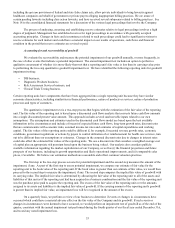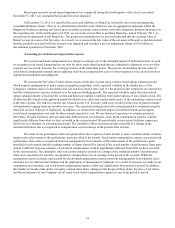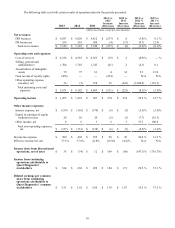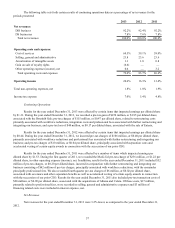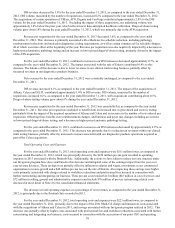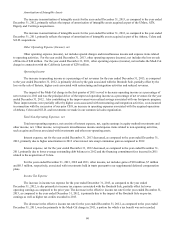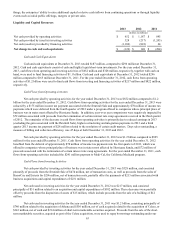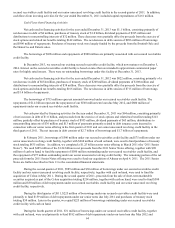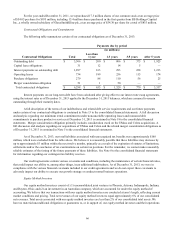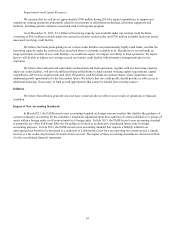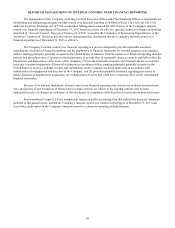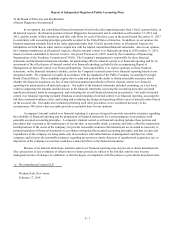Quest Diagnostics 2013 Annual Report Download - page 66
Download and view the complete annual report
Please find page 66 of the 2013 Quest Diagnostics annual report below. You can navigate through the pages in the report by either clicking on the pages listed below, or by using the keyword search tool below to find specific information within the annual report.62
December 31, 2013, $200 million was outstanding under our floating rate senior notes due March 2014 and there were no
borrowings outstanding under our $525 million secured receivables credit facility or under our $750 million senior unsecured
revolving credit facility.
We seek to mitigate the variability in cash outflows that result from changes in interest rates by maintaining a balanced
mix of fixed-rate and variable-rate debt obligations. In order to achieve this objective, we have entered into interest rate swaps.
Interest rate swaps involve the periodic exchange of payments without the exchange of underlying principal or notional
amounts. Net settlements are recognized as an adjustment to interest expense.
In prior years, we entered into various fixed-to-variable interest rate swap agreements with an aggregate notional
amount of $550 million and variable interest rates based on six-month LIBOR plus 0.54% and one-month LIBOR plus 1.33%.
In July 2012, we monetized the value of these interest rate swap assets by terminating the hedging instruments. The asset
value, including accrued interest through the date of termination, was $72 million and the amount to be amortized as a
reduction of interest expense over the remaining terms of the hedged debt instruments was $65 million. Immediately after the
termination of these interest rate swaps, we entered into new fixed-to-variable interest rate swap agreements on the same Senior
Notes. The interest rate swap agreements we entered into in July 2012 have an aggregate notional amount of $550 million and
variable interest rates based on six-month LIBOR plus 2.3% and one-month LIBOR plus 3.6% and are accounted for as fair
value hedges of a portion of the Senior Notes due 2016 and a portion of the Senior Notes due 2020. During the fourth quarter
of 2012, we entered into additional fixed-to-variable interest rate swap agreements with an aggregate notional amount of $400
million and variable interest rates based on one-month LIBOR plus a spread ranging from 3.4% and 5.1%. These derivative
financial instruments are accounted for as fair value hedges of a portion of the Senior Notes due 2015 and a portion of the
Senior Notes due 2021. In November 2013, we terminated the interest rate swaps associated with the Senior Notes due 2015.
The asset value of these interest rate swaps through termination was not material. Concurrent with the termination of the
interest rate swaps associated with the Senior Notes due 2015, we entered into additional fixed-to-variable interest rate swap
agreements with an aggregate notional amount of $200 million and variable interest rates based on one-month LIBOR plus a
spread ranging from 2.45% to 2.46%. These derivative financial instruments are accounted for as fair value hedges of a portion
of the Senior Notes due 2021. Based on our net exposure to interest rate changes, a hypothetical 10% change in interest rates
on our variable rate indebtedness (representing 2 basis points) would not impact annual interest expense materially, assuming
no changes to the debt outstanding at December 31, 2013.
The aggregate fair value of the fixed-to-variable interest rate swap agreements related to our Senior Notes due 2016,
2020 and 2021 was a liability of $34 million at December 31, 2013. A hypothetical 10% change in interest rates (representing
20 basis points) would potentially change the fair value of the liability by $10 million.
During the fourth quarter of 2013, we entered into various forward starting interest rate swap agreements with an
aggregate notional amount of $100 million and fixed interest rates ranging from 3.625% to 3.744%. The forward interest rate
swap agreements are 23 to 24 month forward agreements covering a ten-year hedging period and were entered into to hedge
part of our interest rate exposure associated with forecasted debt issuances related to the refinancing of certain debt maturing in
2015 and 2016. The fair value of the forward starting interest rate swaps was an asset of $2 million at December 31, 2013. A
hypothetical 10% change in interest rates (representing approximately 40 basis points) would potentially change the fair value
of the asset by $3 million.
For further details regarding our outstanding debt and our financial instruments, see Notes 13 and 14, respectively, to
the consolidated financial statements.
Risk Associated with Investment Portfolio
Our investment portfolio includes equity investments comprised primarily of strategic equity holdings in privately
held companies. These securities are exposed to price fluctuations and are generally concentrated in the life sciences industry.
The carrying value of our equity investments was $13 million at December 31, 2013.
We regularly evaluate the fair value measurements of our equity investments to determine if losses in value are other
than temporary and if an impairment loss has been incurred. The evaluation considers whether the security has the ability to
recover and, if so, the estimated recovery period. Other factors that are considered in this evaluation include the amount of the
other-than-temporary decline and its duration, the issuer’s financial condition and short-term prospects and whether the market
decline was caused by overall economic conditions or conditions specific to the individual security.
We do not hedge our equity price risk. The impact of an adverse movement in equity prices on our holdings in
privately held companies cannot be easily quantified, as our ability to realize returns on investments depends on, among other



